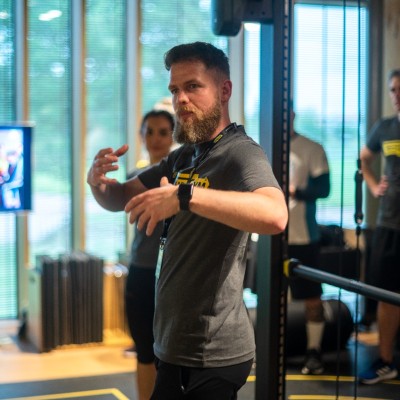Refining your coaching ear as a fitness professional. David Howatson guides you through an easy system to simplify the things your coaching ear should be listening out for.
In conversation, spotting the difference between positive and negative talk is something most listeners are fairly comfortable with. As coaches we pick up on tone, rhythm, body language and facial cues, as well as the specific words themselves. However, a common trap that can catch us all at any time is to treat this feedback as binary. The subtleties can slip through the gaps in our listening skills if we box things as purely positive or negative.
Missing the kind of talk that can lead to modification of behaviour – change talk – slows the process. Likewise, ignoring phrases which impede change – your Negative Nelly or sustain talk – only serves to let those words dominate the psyche of the talker. Wouldn’t it be nice to have an easy system to simplify the things your coaching ear should be listening out for?
DARN good listener
Thankfully clinical psychologists William R Miller and Stephen Rollnick developed techniques during their work in addictions which can be applied to our conversations with clients, patients and athletes in our care. The DARN method is a good starting point for easing into a better set of listening skills. Firstly, who doesn’t love an acronym? Secondly, here is what it stands for:
D – Desire: “I want”, “I would enjoy”, “wish”, “like” and “love”
A – Ability: “I can”, “I could”, “I am able to”, “it’s possible that”
R – Reasons: “I might feel much better if”, “if I gained muscle I could”
N – Need: “I must”, “I have to”, “I’ve got to” or simply “I need to”
Categorising the words and phrases of your clients in this way helps to filter the useful from the not so useful in your interactions. Desire driven language is the talker expressing a preference for change. Ability statements are the talker showing confidence in their capacity. Reasons drum up their argument or intentions for change with the magic word ‘if’. Our reasons can slip through that listening gap, so pay close attention as they suggest your client is envisioning change. Lastly, Need statements are those which show an obligation to or necessity for change. These can often be the strongest transformational terms so must be picked up by the listener when the aim is to reinforce that need.
Here’s the bad news. DARN also applies to what we might label as the negative talk that sustains the status quo and helps the individual avoid change:
“I love smoking.”
“I could just stay in bed.”
“If I take up running, I’ll get injured.”
“I need to be a social drinker.”
OK, maybe these examples aren’t so subtle but identifying the message our talker is putting out there is key in coaching change. Hearing DARN statements is your cue as the listener to dive deeper into the intent behind the words.
CATS me if you can
Next-level change talk is easy to classify if we use CATS as our second acronym of the day (and notably it’s the only time cats are better than dogs):
C – Commitment: “I swear” or “I guarantee I will”
A – Activation: “I am ready to” or “now is the time for”
TS – Taking Steps: “I went to” or “I signed up for”
Use of statements like these is a good indicator that a person is either ready to or is already in the process of change. Solid commitment and activation phrases indicate the talker has bought into the plan for change or, at worst, is willing to buy. Taking steps means we’ve gone from intent to action. Lovely.
You’ll notice CATS statements show a stronger level of intent than those related to DARN, so bank them in your interactions with clients. Affirm and vocalise your recognition of the fact that the person has taken action to sign up for a class or went to see their doctor for a physical check. Start to co-plan the next steps when you hear they are ready and remind them of the strength of their commitment once they’ve uttered “I guaran-damn-tee I will!”
Asking simple open questions based on the DARN and CATS chat you hear can expand the conversation around more positive behaviours. Injecting these concepts into your conversational repertoire is a safe place to start building your active listening skills. More on open questions and change talk to come but, in the meantime, enjoy some easy listening.
Read David’s blog on submaximal testing for Hyrox rowing

David Howatson
David Howatson has over a decade of experience in the fitness industry. He currently delivers education, creates content and presents internationally for Technogym and Power Plate as well as being a member of British Rowing’s Go Row Indoor master trainer team.








